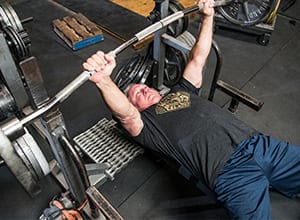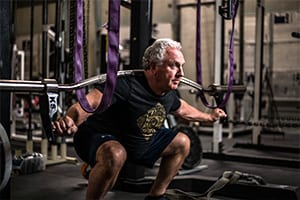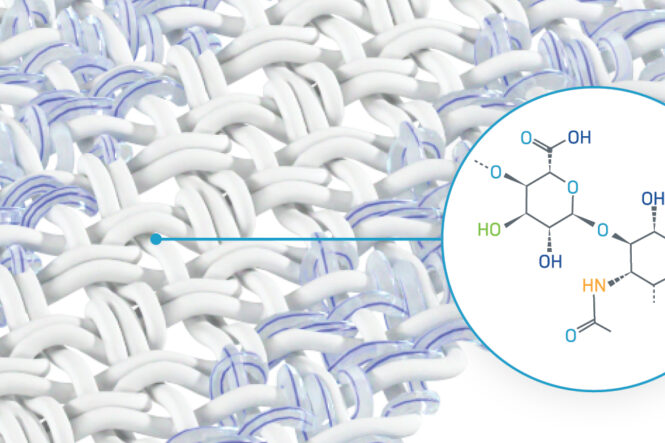 Rudy Kadlub is a Powerlifting World Record holder (pre & post shoulder implants), Co-Owner of Kabuki Strength in Portland, Oregon, and Arthrosurface bilateral OVO® with Inlay Glenoid Total Shoulder patient. We recently caught up with him for some fitness tips to utilize at home throughout the ongoing COVID-19 pandemic, and how he overcame shoulder pain with the OVO® with Inlay Glenoid Shoulder Arthroplasty System.
Rudy Kadlub is a Powerlifting World Record holder (pre & post shoulder implants), Co-Owner of Kabuki Strength in Portland, Oregon, and Arthrosurface bilateral OVO® with Inlay Glenoid Total Shoulder patient. We recently caught up with him for some fitness tips to utilize at home throughout the ongoing COVID-19 pandemic, and how he overcame shoulder pain with the OVO® with Inlay Glenoid Shoulder Arthroplasty System.
Q1. How have you stayed active during the pandemic?
Getting away from your daily routine is difficult. Due to my age and being a part of a more vulnerable population, I’ve tried to stay away from my gym, Kabuki Strength. I’ve had my team bring me some equipment like bars, plates, and racks so I can train at home. But it’s not easy to do at home without a training partner for very heavy weights. Although I’ve had to make adjustments to my training, I haven’t missed a workout at all. In fact, I’m probably working out more than usual. I save 45 minutes to 1 hour in commute time, and with that free time I’m able to increase training time.
Q2. You have a unique perspective as a business owner. What can you tell us about the disruption the global  pandemic has caused personally and professionally?
pandemic has caused personally and professionally?
At Kabuki Strength, we have a couple sources of revenue. We manufacture strength equipment, and about 20% of our revenue comes from education and coaching. Even pre-COVID-19, our education and coaching were all done online. We have six full-time trainers with clients all over the world. We saw a dip in our educational revenue during the first couple of weeks of stay at home orders; because some of our clients who may have experienced a loss of work are being cautious about how they spend money.
On the other hand, the equipment side of the business has really increased. As gyms around the country have had to close; people were scrambling to get equipment to set up a home gym. The silver lining of it all is our manufacturing side of the business has really benefitted. We’ve been fortunate and blessed that our revenue has actually increased during this time.
Q3. Tell us your story. When did you start experiencing pain in your shoulders?
I started powerlifting fairly late in life, in my mid 50’s. I was using the tools available to me at the time, which included the typical power bar/straight bar used in weightlifting. Over the course of 7-9 years of training, I felt my shoulder pain increasing.
Back when I was a young athlete playing college football, I had a shoulder separation. Around the same time in my early 20’s, I suffered an AC joint separation while skiing. I had some prior shoulder issues stemming from that time, but they didn’t really manifest until I got heavy weight training into my 50’s. About five years in, I started feeling pain in my shoulders and restriction in range of motion. I visited my orthopedic surgeon here in Portland, who took some x-rays and found arthritis in my shoulders. He did a couple of cortisone injections for relief; and indicated that at some point I may be a candidate for full shoulder replacement.
Q4. What other options did you consider before receiving bilateral OVO® with Inlay Glenoid Shoulder implants in 2016?
I did more research and realized that if I did a full traditional shoulder replacement; I wouldn’t be able to continue with the sport that I had grown to love and at which I was having great success. By 2010-2011, I had set at least a few powerlifting world records. Every year I went back to my orthopedic surgeon for more injections and even underwent arthroscopic surgery back in 2014 to clean up some loose bodies but never really got the relief I wanted. I went back again in 2015, and my pain and range of motion was even worse.
I thought to myself, there’s got to be something else out there besides a complete traditional shoulder replacement. I saw that there were surgeries for partial knees and hips, so I asked my surgeon if there was a similar procedure for shoulders.
That’s when my surgeon told me about Dr. Anthony Miniaci at the Cleveland Clinic, and the positive results he’s had with a less invasive, joint preservation shoulder procedure. Once I found out I could keep training and powerlifting with it, I said sign me up! I flew to Cleveland to meet with Dr. Miniaci, and through x-rays and MRIs he determined that I was a candidate for the OVO® with Inlay Glenoid Shoulder Arthroplasty System from Arthrosurface.
I had the procedure done on my right shoulder first, in May of 2016, and then flew back about six months later in October to have the procedure done on my left shoulder. I did my right shoulder first because I am right-handed. About 7-8 months post-surgery, I was back up and running and actually set a couple of world powerlifting records. Since I’ve recovered from surgery, I’ve continued to train and compete. In the last two years, I’ve won the world championship and have set new records. This year, the championships have been canceled due to the Covid19 pandemic but I am continuing to train.
Post-surgery, the pain I initially experienced subsided significantly. Over time, my range of motion returned and the pain dissipated to a point of almost forgetting I had even had surgery. I have no pain at all at this point and excellent range of motion. I continue to train hard and don’t see any issues going forward.

Q5. How has your life changed since receiving the bilateral OVO® with Inlay Glenoid Shoulder implants?
The most significant change is that I can now sleep without constantly waking up due to pain. For about 4-5 years I couldn’t get a restful night of sleep because of the shoulder pain. Any movement, right or left, would cause enough pain to wake me up. Health-wise, being able to sleep well again has been the greatest benefit.
Since receiving the shoulder implants, my range of motion is much better than it was prior to surgery. I’m able to train pain-free and use heavier weights. The numbers that I set at the world championship in Limerick, Ireland in October of 2019 were greater than the ones I set 2-3 years ago, or even pre-surgery.
Prior to surgery, the pain made it difficult to even get dressed and put on a coat. I got to a point where I didn’t wear a coat, even when it was cold. If I didn’t have someone with me to help me put my coat on, I was like a dog chasing its tail to get dressed. It’s a simple thing, but people that have shoulder issues have similar experiences. Now I can throw on a coat and I’m ready to go. Life is simpler.
Q6. What helped you as you got back into training for World Championships post-surgery?
The products that we create at Kabuki Strength are a paradigm shift from the traditional strength training equipment. When I first started training, I used what was available such as the straight bar; which puts undo stress on the shoulder/joint and on the bicep tendon.
About 5 years ago, Kabuki Strength created a revolutionary new bar called the Duffalo Bar, a specialty bar used for all squatting and pressing variations. It has proprietary bends, which puts less stress and rotational demand on the shoulder. It puts the shoulder in a more centrated position than a straight bar and therefore reduces the risk of injury. In my case, it was also a great rehab tool post-surgery. I got back to training sooner by training with that piece of equipment; one of the reasons I was able to get on the platform sooner rather than later. I was able to continue building strength without stressing the joint.
We continue to build products that relieve pressures on the joint. Like the Duffalo Bar, the Kadillac Bar, the world’s best bench press bar, puts the shoulders in a more neutral position and prevents internal rotation. The curve in the bar allows for an increased range of motion and therefore a greater training effect. The Transformer Bar allows people to squat without putting their hands behind their back. I train with these bars year-round. I only go back to the straight bar 2-3 weeks before a competition to get acclimated.
Q7. What is your advice to others considering this surgery?
Some physicians are familiar with it, but other surgeons may be more comfortable doing a full traditional total shoulder replacement or reverse shoulder replacement. For anyone who is active and wants to remain active, whether they are a skier, waterskier, or bowler (sports I continue to enjoy), they should really consider the Arthrosurface Anatomic Total Shoulder Arthroplasty Systems. These systems allow you to remain active, take care of the pain, and help you get back to full range of motion or nearly full range of motion.
People should do their research if their doctor recommends a full traditional shoulder replacement. I would ask your doctor to look into the Arthrosurface option; and if they don’t have experience with it, ask them to recommend a doctor who does.
Learn More
You can view Rudy’s original testimonial for Arthrosurface here.
For more information on the Shoulder HemiCAP® system, and the anatomic OVO® / OVOMotion® with Inlay Glenoid Shoulder Arthroplasty System please visit https://www.arthrosurface.com/shoulder-implants/.
You can also find a physician using Arthrosurface implants in your area with our‚ÄØFind the Doctor‚ÄØtool. Don’t see anyone in your area? ‚ÄØContact Us‚ÄØ and we will be happy to help!




